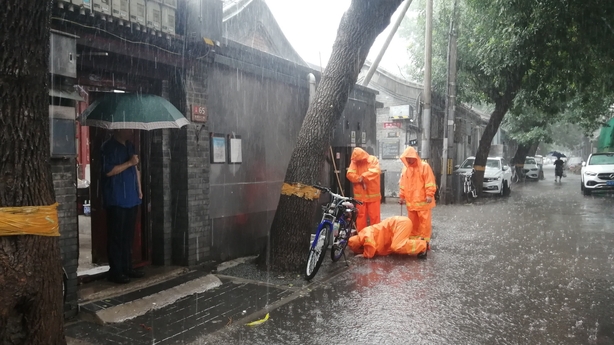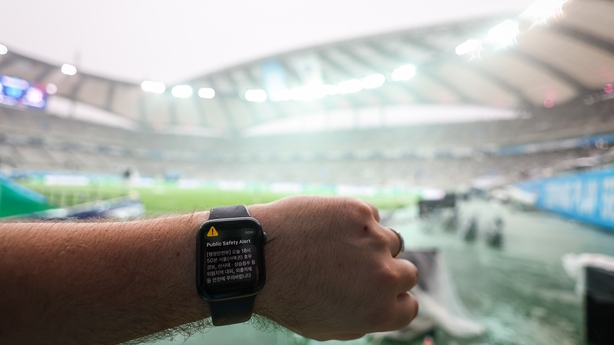Deadly rains that pummelled China's capital in recent days were the heaviest since records began 140 years ago, Beijing's weather service has said, as a massive cleanup operation began.
Millions of people have been hit by extreme weather events and prolonged heat waves around the globe in recent weeks - events that scientists say are being exacerbated by climate change.
And the Beijing Meteorological Service said the capital has just experienced the "heaviest rainfall in 140 years", when city authorities started keeping records.
"The maximum (amount) of rainfall recorded during this storm, which was 744.8 millimetres, occurred at the Wangjiayuan Reservoir in Changping," the service said, adding the largest volume previously recorded was 609 millimetres in 1891.
At least 11 people have died in the rains in Beijing, state broadcaster CCTV said yesterday, with more than a dozen missing.
The epicentre of flooding shifted to neighbouring Hebei province today.
In Beijing's Fangshan district - on the border between the capital and Hebei - an AFP team saw a park that had been completely flooded, with tons of rubbish that had been washed away by torrential rains stuck near a bridge.
The area had been "extremely dangerous" yesterday, a police officer said.
Journalists also saw a military vehicle with caterpillar wheels on its way back from the most affected areas.
And in the opposite direction, AFP saw an ambulance, a rescue boat and a police car heading to Zhuozhou, a hard-hit district of Hebei.
Read more: At least one dead after Typhoon Khanun hits Japan's Okinawa
State media footage showed rescuers rowing inflatable rafts through waterlogged neighbourhoods, while locals clung to construction scaffolding awaiting help.
Storm Doksuri, a former super typhoon, swept northwards over China after hitting southern Fujian province last week, following its battering of the Philippines.
Heavy rains began pounding the typically dry capital and surrounding areas on Saturday.
The amount recorded in just 40 hours neared the average rainfall for the entire month of July.
State media warned last week that 130 million people would be affected by the extremely heavy rainfall across northern China.
Swathes of suburban Beijing and the surrounding areas have been inundated, with state media reporting 974,400 people have been evacuated in the capital and neighbouring Hebei province.
And to the west, a further 42,211 people have been evacuated in Shanxi province.
Authorities in the capital lifted the red alert for flooding on Wednesday morning "as the water flow in major rivers has gone below the warning mark", Xinhua reported.

Clean-up drive
With rainfall easing, the focus has moved to the relief operation, with hundreds of rescue workers from the Chinese Red Cross being sent to hard-hit areas to clean up debris and help evacuate victims, state news agency Xinhua reported.
Two of the 11 people killed in the rains in Beijing died while "on duty during rescue and relief", according to state broadcaster CCTV.
Thirteen people were still missing, but another 14 have been found safe, the broadcaster said.
In neighbouring Hebei province, nine people were killed and six were missing, it said.
Another two casualties were reported in northeastern Liaoning province over the weekend.
President Xi Jinping on Tuesday called for "every effort" to rescue those "lost or trapped" by the storm.
And visiting a relief work site in Beijing's Mentougou - one of the capital's hardest-hit areas - Vice-Premier Zhang Guoqing urged "all-out" efforts to rescue those still missing.
"The top priority of the current work is to save people's lives, race against the time to search for the people missing or trapped and minimise casualties," Zhang said, according to state news agency Xinhua.
South Korea raises heat alert to highest amid sweltering weather
Meanwhile, South Korea raised its hot weather warning to its highest level for the first time in four years, as parts of the country roasted in temperatures over 38 degrees Celsius, the interior and safety ministry has said.
The scorching heat is estimated to have killed at least 22 people across the country as of yesterday, more than triple the record of seven during the same period last year, an official at the National Fire Agency said.
The official temperature measured in the city of Yeoju, south of Seoul, hit 38.4C yesterday, the Ministry of the Interior and Safety said.
South Korea raised the heat warning level in its four-tier system to the highest as of 6 pm local time yesterday, the first time since 2019.
The highest "serious" warning is issued when the apparent temperature is expected at 35C or higher in at least 40% of the country's 180 regions for three or more days.
It can also be issued when the apparent temperature is likely to be 38C or higher for three or more days in 10% of the country.
"This weather gets me really sweaty just by walking around," Cho Ye-jin, a 21-year-old college student said, holding a portable fan in one hand in the tourist district of Myeongdong, Seoul.
"You can't bear this weather without a fan."

In the southern county of Buan where the 25th World Scout Jamboree is taking place, some 400 participants have experienced heat-related symptoms on its opening day yesterday, officials said.
"Most of them were experiencing mild symptoms, such as temporary headache, and there is no one being treated as a serious patient," its organising committee said in a statement.
The committee said it had six helicopters and 70 hospital beds ready to transfer patients in case of emergency.
Some 43,000 people from across the globe are planned to take part in the camping festival which will run through 12 August, the committee said.
The government forecasts high temperatures to persist with oppressive humidity for the coming days, with the apparent temperature likely to hover around 35C in most parts of the country.
President Yoon Suk Yeol yesterday urged officials to step up measures to prevent further casualties, especially for people working outdoors, the elderly citizens and those living in makeshift houses without adequate air conditioning systems.
Near Mr Yoon's office, construction workers held a press conference and called for concrete countermeasures.
"Under the current conditions, construction workers' heat deaths are 'expected deaths,'" the Korean Confederation of Trade Unions said in a statement.
The growing frequency and intensity of severe weather is symptomatic of global, human-driven climate change, experts in the field say, with heatwaves in much of the world expected to persist through August.
North Korea is also battling the unrelenting heatwave with highest daily temperatures forecast to hover around 35C to 37C by tomorrow, state media reported


